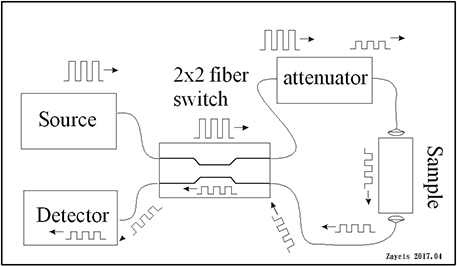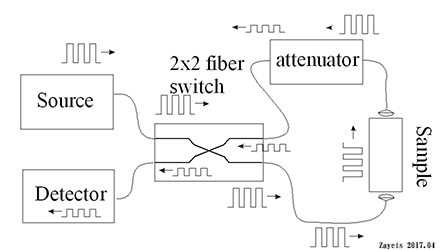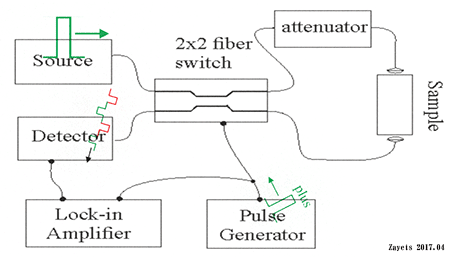Measurement of non-linear refractive index and non-linear optical absorption
High-precision high-sensitivity measurements
The measurement setup with a 2x2 optical allows to measure a very small non-linear change of optical absorption and refractive index with a very high precision.
 Zayets et al, Patent appl., 2016-126905, 2016;
Zayets et al, Patent appl., 2016-126905, 2016;  in Japanese;
in Japanese;  in English
in English
 Q. Why it is difficult to measure a non-linear change the optical absorption and the refractive index. It is just could be measured by varying the intensity of a light source while measuring the absorption and the refractive index?
Q. Why it is difficult to measure a non-linear change the optical absorption and the refractive index. It is just could be measured by varying the intensity of a light source while measuring the absorption and the refractive index?
 A. The non-linear change of the optical absorption and refractive index in a material is usually very small. The optical properties of other optical measurement circuit may depend significantly on the light intensity. It requires a very precise calibration of all optical components for different light intensities. In particularly, it is very difficult to calibrate the photo detector when light intensity changes in a wide range. Additionally, the optical and electrical noise make near impossibly to detect a tiny change of light intensity due to non-linear properties of a material.
A. The non-linear change of the optical absorption and refractive index in a material is usually very small. The optical properties of other optical measurement circuit may depend significantly on the light intensity. It requires a very precise calibration of all optical components for different light intensities. In particularly, it is very difficult to calibrate the photo detector when light intensity changes in a wide range. Additionally, the optical and electrical noise make near impossibly to detect a tiny change of light intensity due to non-linear properties of a material.
Merits of proposed measurement setup
Merits of using 2x2 switch:
1) It allows to keep exactly the same light intensity at all component of measuring setup. Only the light intensity at sample is varying. In particular, it is critically important that the light intensity at the light source and the light detector does not change when intensity at sample changes significantly.
2) It allows to use the lock-in technique. It suppresses substantially the noise level and increases the sensitivity.
Fig. 1. Setup for measurements of non-linear change of optical absorption |
The case of a lower intensity
|
The case of a higher intensity |
 |
 |
| At first, light passes through the attenuator and next smaller intensity light passes through the sample. |
At first, higher-intensity light passes through the sample and next it passes through the attenuator. |
|
| At left case, light of a lower intensity passes through the sample. At left case, light of a lower intensity passes through the sample. It is critically important that in both cases the intensity of emitted light at the sources is the same and the the intensity of detected light at the detector is nearly the same. There is a small difference of the detected signal due to the non-linear absorption of the sample. Click on image to enlarge it |
Measurements of non-linear change of optical absorption
Figure 1 shows the proposed setup for measurements of non-linear absorption. Figures 1 (a) and (b) show two switch states of the switcher. The attenuator is inserted between the sample and the fiber switcher. For one switching state of the switcher, light is passing the absorber at first and next the sample (Fig.1 (a)). For another switching state of the switcher, it is opposite. Light is passing through the sample at first and next through the absorber (Fig.1 (b)). Therefore, light of different intensity is passing through the sample for the different switching states. In contrast, at detector the intensity of light is nearly-same for both switching states. It is because for both switching states, light is passing through all the same elements on the path from the source to the detector. In the case when the absorption of the sample does not depend on the light intensity, the intensity of light at the detector is exactly the same for both switching states. In the case when the absorption of the sample is dependent on the light intensity, there is a tiny difference in intensity of light at the detector. This difference can be measured with a high precision using the lock-in technique and the non-linear absorption of the sample can be evaluated. In the case when an tunable attenuator is used, the dependence of the non-linear absorption on light intensity can be measured.
Setup for measurements of non-linear change of optical absorption using lock-in technique |

|
| The electrical pulses from the pulse generator switch the 2x2 optical switch. It change intensity of light, which passes through the sample. As result, the detected signal is modulated with amplitude, which is proportional to the non-linear change of the absorption in the sample. Click on image to enlarge it |
Measurements of non-linear change of refractive index
This method was

